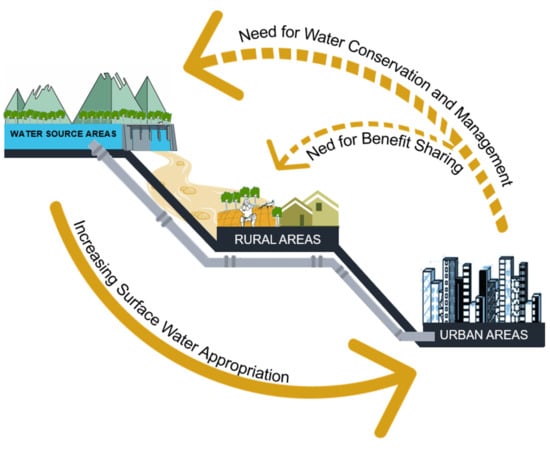Addressing Urban–Rural Water Conflicts in Nagpur through Benefit Sharing
Abstract
:1. Introduction
2. Literature Review
2.1. Urban–Rural Water Conflicts
2.2. Water Governance Challenges and Opportunities
2.3. Significance of Benefit Sharing Measures
2.4. PES Schemes for Water Environment Conservation in Japan
2.4.1. Prefectural Inhabitant Tax for Water-Source Conservation in Kanagawa, Japan
- Planning: The Prefectural government formulated a ‘Five-Year Action Plan for Conservation and Restoration of Water Source Environment’ in the year 2006, which listed 12 comprehensive initiatives (such as forestry conservation, groundwater protection, awareness raising) to be carried out under the Basic Policy. This plan listed out specific measures for engaging in water-source environment conservation during the first five years of the twenty-year period.
- Taxation system: After a thorough investigation of water-source environment, it was estimated that additional costs of around 19 billion Japanese yen (JPY; around 3.8 billion JPY per fiscal year) would be required to implement the 12 defined programs during the first five years. To sustainably finance these programs, the Kanagawa prefectural inhabitant tax was increased by a fixed rate of 300 JPY per year, and the ratio of original tax was increased by 0.025% of their income. These tax rates are revised every five years to meet the estimate costs of implementing the defined action plans. However, the most notable point here is that the basis for calculation of tax amounts, the anticipated revenue and the planned usage of this tax is clearly demonstrated to the prefectural residents at the very beginning. To maintain complete transparency in the usage of this earmarked tax revenue, a new special account is established named ‘Kanagawa Prefectural Government Account for Conservation and Restoration of Water Source Environment Programs’, within which ‘Kanagawa Prefectural Government Fund for Conservation and Restoration of Water Source Environment’ is created.
- Resident participation: The Prefectural government established a ‘Prefectural Resident Council’ in FY2007 to enhance the participation of prefectural residents in transparent utilization of funds. The council not only mainstreams the opinions of prefectural residents, but also evaluates and reviews the planned measures to conserve and restore water-source environments. The council also sets up an expert committee to verify the implications of proposed projects, which comprise experts, publicly recruited committee members, civil society, government officials, etc.
3. Case Study Area—Nagpur, India
3.1. Water Supply in Nagpur City
- Gorewada Lake: Developed in the year 1911, Gorewada Tank is one of the oldest water sources of Nagpur. It is situated at a distance of around 8 km from Nagpur City in the northwest direction and consists of an earthen bund across Pili River. The city annually receives an allocated quantity of 5.8 million cubic meters (MCM) (around 16 MLD) from Gorewada Lake [103]. Over the years, Gorewada Lake has become inadequate to meet the growing water demands in the city, as it could not be augmented due to site conditions. In the year 2019, the lake got dry for the first time in more than 100 years [60].
- Kanhan River: First constructed in 1940, the Kanhan water-supply scheme was commissioned in four phases during the years 1940–70. Under this scheme, intake wells were developed along Kanhan River from which raw water is pumped to a treatment plant. Located at a distance of around 14 km from Nagpur City, Kanhan intake wells serve for around 25% of city’s water demands. Nagpur presently receives an annual allocation of around 65.71 MCM (around 180 MLD) from Kanhan Intake wells [103]. In the recent years, the raw water availability in Kanhan River has declined due to the development of Kochi barrage in upstream areas [59,62], which has considerably affected the water supply in Nagpur City.
- Pench Dam: Across the Pench River, Navegaon Khairy Dam (Pench Dam) was executed in the year 1976, by the State Irrigation Department, to utilize the tail races from hydropower project at Totladoh dam, developed near the state boundary with Madhya Pradesh (M.P.). Thereafter, multiple augmentation schemes (Pench I, II, III, and IV) were commissioned to enhance its capacity. Located at around 45 km away from Nagpur City, Pench Dam presently serves as the main source of water supply for the city. The city receives an annual allocation of 190 MCM (around 520 MLD) from the project, that is more than 70% of the total water supply to Nagpur City [103]. In the recent years, Nagpur City has experienced significant disruptions in water supply due to the declining water availability in Pench Dam [61,62,63,64,65].
4. Research Methods
- Annual water utilization trends (1990 to 2019) from the Pench Project, for the purposes of Irrigation, NMC (urban domestic), and industries (thermal power stations).
- Total irrigated area, annually (2001 to 2019), from the Pench Project, in different seasons (Kharif, Rabi, and Zaid (hot weather)).
- Total irrigated area, annually (2001 to 2019), from the Pench Project, using different irrigation methods (flow, lift, and well).
5. Results
5.1. Historical Timeline of Pench Project
5.2. Increased Water Transfer from Pench Irrigation Project to Nagpur City
5.3. Cross-Sectoral Implications of Increased Water Transfer to Nagpur City
5.4. Transboundary Implications of Increased Water Transfer to Nagpur City
6. Discussion
6.1. Implementing Benefit Sharing Measures at Policy and Governance Levels
- Planning: To achieve transboundary cooperation for collective water management, emphasis should be put on establishment of benefit sharing agreements between the key stakeholder groups like NMC, TPSs, WUAs, and other agencies, depending on the scale of consideration, like regional level, district level, or state level. With an agreed long-term strategy, an action plan should be developed to achieve sustainable water resource management at regional level.
- Taxation system: Based on the estimated costs for implementing the defined projects, the possibilities of additional water tax or incentivization measures need to be explored by NMC, as it has the power to take decisions regarding consumer level pricing and taxation at city level. Based on a thorough needs assessment study at regional level and the assessment of urban consumer’s ‘Willingness to Pay’, a feasible water taxation policy needs to be developed.
- Resident Participation: Needless to say, it will be important to ensure the social acceptance of any such intervention, as these agreements can arise voluntarily if the service providers and users feel their merits [128]. To achieve that, more emphasis needs to be put on raising community awareness about the intensifying water scarcity and escalating pressures on water resources in NMA. An agreed monitoring mechanism for utilization of collected funds by varying stakeholder groups—like in the case of Kanagawa (refer to Section 2.4.1)—will go a long way to ensure transparency and inclusiveness.
6.2. Enabling Multi-Stakeholder Engagement for Integrated Water-Resource Management
7. Conclusions
Author Contributions
Funding
Acknowledgments
Conflicts of Interest
References
- United Nations Water. Sustainable Development Goal 6: Synthesis Report on Water and Sanitation 2018; The United Nations: New York, NY, USA, 2018; Available online: www.unwater.org/app/uploads/2018/07/SDG6_SR2018_web_v5.pdf (accessed on 2 September 2020).
- Food and Agriculture Organization (FAO). Progress on Level of Water Stress—Global Baseline for SDG 6 Indicator 6.4.2; Food and Agriculture Organization of the United Nations (FAO) and United Nations Water (UN-Water): Rome, Italy, 2018; Available online: http://www.fao.org/3/CA1592EN/ca1592en.pdf (accessed on 2 September 2020).
- World Water Assessment Programme (WWAP). The United Nations World Water Development Report 2019: Leaving No One Behind; The United Nations Educational, Scientific and Cultural Organization (UNESCO): Paris, France, 2019; Available online: https://en.unesco.org/themes/water-security/wwap/wwdr/2019 (accessed on 2 September 2020).
- Kummu, M.; Guillaume, J.H.A.; de Moel, H.; Eisner, S.; Flörke, M.; Porkka, M.; Siebert, S.; Veldkamp, T.I.E.; Ward, P.J. The world’s road to water scarcity: Shortage and stress in the 20th century and pathways towards sustainability. Sci. Rep. 2016, 6, 38495. [Google Scholar] [CrossRef] [PubMed] [Green Version]
- Cosgrove, W.J.; Loucks, D.P. Water management: Current and future challenges and research directions. Water Resour. Res. 2015, 51, 4823–4839. [Google Scholar] [CrossRef] [Green Version]
- Water Scarcity—Science Daily. Available online: https://www.sciencedaily.com/terms/water_scarcity.htm (accessed on 2 September 2020).
- Water Stress—European Environment Agency. Available online: https://www.eea.europa.eu/archived/archived-content-water-topic/wise-help-centre/glossary-definitions/water-stress (accessed on 2 September 2020).
- World Health Organization (WHO). Factsheet on Drinking Water. Available online: http://www.who.int/mediacentre/factsheets/fs391/en/ (accessed on 2 September 2020).
- World Economic Forum (WEF). The Global Risks Report 2019, 14th ed.; World Economic Forum (WEF): Geneva, Switzerland, 2019; Available online: http://www3.weforum.org/docs/WEF_Global_Risks_Report_2019.pdf (accessed on 2 September 2020).
- Intergovernmental Panel on Climate Change (IPCC). Climate Change 2014: Synthesis Report. Contribution of Working Groups I, II and III to the Fifth Assessment Report (AR5) of the Intergovernmental Panel on Climate Change; Pachauri, R.K., Meyer, L.A., Eds.; IPCC: Geneva, Switzerland, 2014; Available online: https://www.ipcc.ch/site/assets/uploads/2018/05/SYR_AR5_FINAL_full_wcover.pdf (accessed on 2 September 2020).
- Mancosu, N.; Snyder, R.L.; Kyriakakis, G.; Spano, D. Water scarcity and future challenges for food production. Water 2015, 7, 975–992. [Google Scholar] [CrossRef]
- Saqalli, M.; Thiriot, S.; Amblard, F. Investigating social conflicts linked to water resources through agent-based modelling. NATO Sci. Peace Secur. Serv. 2010, 75, 142–157. Available online: https://halshs.archives-ouvertes.fr/halshs-00918476 (accessed on 2 September 2020).
- Daniell, K.A.; Coombes, P.J.; White, I. Politics of innovation in multi-level water governance systems. J. Hydrol. 2014, 519, 2415–2435. [Google Scholar] [CrossRef]
- Asia Society Asia’s Next Challenge: Securing the Region’s Water Future. A Report by the Leadership Group on Water Security in Asia. 2009. Available online: https://asiasociety.org/files/pdf/WaterSecurityReport.pdf (accessed on 2 September 2020).
- Ray, B.; Shaw, R. Urban Drought: Emerging Water Challenges in Asia; Springer Nature: Singapore, 2019. [Google Scholar] [CrossRef]
- Pandey, K. India World’s 13th Most Water-Stressed Country; The World Resources Institute (WRI): Washington, DC, USA, 2019; Available online: https://www.downtoearth.org.in/news/water/india-world-s-13th-most-water-stressed-country-wri-66066 (accessed on 2 September 2020).
- India Facing ‘Extremely High’ Water Stress, Will Soon Run Out of Water: Report. 2019. Available online: https://www.indiatoday.in/education-today/gk-current-affairs/story/india-extremely-high-water-stress-water-scarcity-report-1578326-2019-08-07 (accessed on 2 September 2020).
- Hofste, R.W.; Reig, P.; Schleifer, L. 17 Countries, Home to One-Quarter of the World’s Population, Face Extremely High Water Stress. 2019. Available online: https://www.wri.org/blog/2019/08/17-countries-home-one-quarter-world-population-face-extremely-high-water-stress (accessed on 2 September 2020).
- Ritchie, H.; Roser, M. Water Use and Stress, Our World in Data. Available online: https://ourworldindata.org/water-use-stress (accessed on 2 September 2020).
- Down to Earth (DTE). 688 Billion Cubic Metres: India’s Water Withdrawals for Agriculture Is the Highest in the World. 2018. Available online: https://www.downtoearth.org.in/news/water/688-billion-cubic-metres-india-s-water-withdrawals-for-agriculture-is-the-highest-in-the-world-60967 (accessed on 2 September 2020).
- Patil, M. India’s Per Capita Water Availability Fell 15% between 2001–2011. Available online: https://archive.indiaspend.com/viznomics/indias-per-capita-water-availability-fell-15-between-2001-2011 (accessed on 2 September 2020).
- Press Trust of India (PTI). India’s per Capita Water Availability to Decline Further; Indian Council of Agricultural Research (ICAR): New Delhi, India, 2019; Available online: https://www.thehindubusinessline.com/economy/agri-business/indias-per-capita-water-availability-to-decline-further-icar/article29342714.ece (accessed on 2 September 2020).
- United Nations, Department of Economic and Social Affairs (UN DESA). World Urbanization Prospects: The 2018 Revision; United Nations, Department of Economic and Social Affairs (UN DESA): New York, NY, USA, 2019; Available online: https://population.un.org/wup/Publications/Files/WUP2018-Report.pdf (accessed on 28 August 2020).
- Flörke, M.; Schneider, C.; McDonald, R.I. Water competition between cities and agriculture driven by climate change and urban growth. Nat. Sustain. 2018, 1, 51–58. [Google Scholar] [CrossRef]
- The World Bank. Water Scarce Cities: Thriving in a Finite World; World Bank Group: Washington, DC, USA, 2018; Available online: http://documents.worldbank.org/curated/en/281071523547385102/ (accessed on 28 August 2020).
- Garrick, D.; Stefano, L.D.; Yu, W.; Jorgensen, I.; O’Donnell, E.; Turley, L.; Aguilar-Barajas, I.; Dai, X.; Leao, R.d.S.; Punjabi, B.; et al. Rural water for thirsty cities: A systematic review of water reallocation from rural to urban regions. Environ. Res. Lett. 2019, 14, 043003. [Google Scholar] [CrossRef]
- ARUP Group Limited. Cities Alive: Water for People; International Water Association (IWA): London, UK, 2018; Available online: https://www.arup.com/perspectives/publications/research/section/cities-alive-water-for-people (accessed on 5 August 2020).
- Zhang, X.; Chen, N.; Sheng, H.; Ip, C.; Yang, L.; Chen, Y.; Sang, Z.; Tadesse, T.; Lim, T.P.Y.; Rajabifard, A.; et al. Urban drought challenge to 2030 sustainable development goals. Sci. Total Environ. 2019, 693, 133536. [Google Scholar] [CrossRef]
- Hoff, H. Understanding the Nexus. Background Paper for the Bonn2011 Conference: The Water, Energy and Food Security Nexus; Stockholm Environment Institute: Stockholm, Sweden, 2011; Available online: https://www.sei.org/publications/understanding-the-nexus/ (accessed on 2 September 2020).
- Djehdian, L.A.; Chini, C.M.; Marston, L.; Konar, M.; Stillwell, A.S. Exposure of urban food–energy–water (FEW) systems to water scarcity. Sustain. Cities Soc. 2019, 50, 101621. [Google Scholar] [CrossRef]
- Sukhwani, V.; Shaw, R.; Mitra, B.K.; Yan, W. Optimizing Food-Energy-Water (FEW) nexus to foster collective resilience in urban-rural systems. Prog. Disaster Sci. 2019, 1, 100005. [Google Scholar] [CrossRef]
- Moore, S.M. Rethinking conflict over water. In Oxford Research Encyclopedia of Environmental Science; Oxford University Press: Oxford, UK, 2016. [Google Scholar] [CrossRef]
- Ballabh, V. Governance of water: Issues and challenges. In Governance of Water. Institutional Alternatives and Political Economy; Ballabh, V., Ed.; SAGE Publications: New Delhi, India, 2008; pp. 3–17. [Google Scholar]
- Celio, M.; Scott, C.A.; Giordano, M. Urban–agricultural water appropriation: The Hyderabad, India case. Geogr. J. 2010, 176, 39–57. [Google Scholar] [CrossRef]
- Kafle, R.P. Understanding Water Conflict: A Study of Conflict among Farmers and between Farmers and Companies in the Godavari Watershed, Kathmandu Valley, Nepal. Master’s Thesis, Wageningen University and Research Centre, Wageningen, The Netherlands, September 2011. Available online: https://edepot.wur.nl/178381 (accessed on 2 September 2020).
- Punjabi, B.; Johnson, C.A. The politics of rural–urban water conflict in India: Untapping the power of institutional reform. World Dev. 2019, 120, 182–192. [Google Scholar] [CrossRef]
- Hoekstra, A.Y.; Buurman, J.; van Ginkel, K.C.H. Urban water security: A review. Environ. Res. Lett. 2018, 13, 053002. [Google Scholar] [CrossRef] [Green Version]
- Newborne, P.; Tucker, J. The Urban-Rural Water Interface: A Preliminary Study in Burkina Faso; Overseas Development Institute (ODI): London, UK, 2015; Available online: https://www.odi.org/publications/10051-urban-rural-water-interface-preliminary-study-burkina-faso (accessed on 2 September 2020).
- United Nations World Water Assessment Programme (WWAP)/UN-Water. The United Nations World Water Development Report 2018: Nature-Based Solutions for Water; The United Nations Educational, Scientific and Cultural Organization (UNESCO): Paris, France, 2018; Available online: http://www.unesco.org/new/en/natural-sciences/environment/water/wwap/wwdr/2018-nature-based-solutions/ (accessed on 2 September 2020).
- Aivazidou, E.; Tsolakis, N.; Iakovou, E.; Vlachos, D. The emerging role of water footprint in supply chain management: A critical literature synthesis and a hierarchical decision-making framework. J. Clean. Prod 2016, 137, 1018–1037. [Google Scholar] [CrossRef] [Green Version]
- Cullet, P.; Bhullar, L.; Koonan, S. Inter-sectoral water allocation and conflicts, perspectives from Rajasthan. Econ. Political Wkly. 2015, 34, 61–69. [Google Scholar]
- Torio, P.C.; Harris, L.M.; Angeles, L.C. The rural–urban equity nexus of Metro Manila’s water system. Water Int. 2019, 44, 115–128. [Google Scholar] [CrossRef]
- Howard, K.W.F. Urban Rural Tensions and Opportunities for Co-Management. Available online: http://www.groundwatergovernance.org/fileadmin/user_upload/groundwatergovernance/docs/Thematic_papers/GWG_Thematic_Paper_3_web.pdf (accessed on 2 September 2020).
- Bjornlund, H.; Zuo, A.; Wheeler, S.; Xu, W.; Edwards, J. Policy preferences for water sharing in Alberta, Canada. Water Resour. Econ. 2013, 1, 93–110. [Google Scholar] [CrossRef]
- Chanya, A.; Prachaak, B.; Ngang, T.K. Conflict management on use of watershed resources. Procedia Soc. Behav. Sci. 2014, 136, 481–485. [Google Scholar] [CrossRef] [Green Version]
- Ratner, B.D.; Meinzen-Dick, R.; May, C.; Haglund, E. Resource conflict, collective action, and resilience: An analytical framework. Int. J. Commons 2013, 7, 183–208. [Google Scholar] [CrossRef]
- Gillet, V.; Mckay, J.; Keremane, G. Moving from local to State water governance to resolve a local conflict between irrigated agriculture and commercial forestry in South Australia. J. Hydrol. 2014, 519, 2456–2467. [Google Scholar] [CrossRef]
- Tayia, A. Transboundary water conflict resolution mechanisms: Substitutes or complements. Water 2019, 11, 1337. [Google Scholar] [CrossRef] [Green Version]
- Barua, A.; Deka, A.; Gulati, V.; Vij, S.; Liao, X.; Qaddumi, H.M. Re-Interpreting cooperation in transboundary waters: Bringing experiences from the Brahmaputra basin. Water 2019, 11, 2589. [Google Scholar] [CrossRef] [Green Version]
- Gorgoglione, A.; Crisci, M.; Kayser, R.H.; Chreties, C.; Collischonn, W. A New Scenario-based framework for conflict resolution in water allocation in transboundary watersheds. Water 2019, 11, 1174. [Google Scholar] [CrossRef] [Green Version]
- Al-Muqdadi, S.W.H. Developing strategy for water conflict management and transformation at Euphrates–Tigris basin. Water 2019, 11, 2037. [Google Scholar] [CrossRef] [Green Version]
- United Nations Development Programme (UNDP). Sustainable Development Goals; United Nations Development Programme (UNDP): New York, NY, USA, 2015; Available online: http://www.undp.org/content/undp/en/home/sustainable-development-goals.html (accessed on 2 September 2020).
- United Nations-Habitat. Implementing The New Urban Agenda By Strengthening Urban-Rural Linkages-Leave No One And No Space Behind; United Nations Human Settlements Programme (UN-Habitat): Nairobi, Kenya, 2017; Available online: https://unhabitat.org/books/implementing-the-new-urban-agenda-by-strengthening-urban-rural-linkages (accessed on 2 September 2020).
- Barbier, E.B.; Chaudhry, A.M. Urban growth and water. Water Resour. Econ. 2014, 6, 1–17. [Google Scholar] [CrossRef]
- Holt, R.; Global Cities. Which Cities will Be Leading the Global Economy in 2035? Oxford Economics: Oxford, UK, 2018. Available online: https://workplaceinsight.net/wp-content/uploads/2018/12/Global-Cities-Dec-2018.pdf (accessed on 2 September 2020).
- Roy, A. Nagpur Division Faces Water Scarcity as Dams only 23% Full. Available online: https://timesofindia.indiatimes.com/city/nagpur/nagpur-divn-faces-water-scarcity-as-dams-only-23-full/articleshow/65015728.cms (accessed on 2 September 2020).
- Arya, S. Dry Totladoh Bodes Ill for City Water Supply. Available online: https://timesofindia.indiatimes.com/city/nagpur/dry-totladoh-bodes-ill-for-city-water-supply/articleshow/66020515.cms (accessed on 2 September 2020).
- Khandekar, N. With Rain Playing Truant in Central India, an Inter-State Water Dispute Brews. Available online: https://thewire.in/environment/nagpur-chhindwara-totladoh-machagora-monsoon-water-shortage (accessed on 2 September 2020).
- Chakraborty, P. Kochchhi Barrage Construction Causing Water Scarcity in City. Available online: https://timesofindia.indiatimes.com/city/nagpur/kochchhi-barrage-construction-causing-water-scarcity-in-city/articleshow/67135009.cms (accessed on 2 September 2020).
- Chakraborty, P. Gorewada Goes Dry First Time in 100 Years. Available online: https://timesofindia.indiatimes.com/city/nagpur/gorewada-goes-dry-first-time-in-100-years/articleshow/69795014.cms (accessed on 2 September 2020).
- Water Crisis in Nagpur: Citizens May Get Water on Alternate Days for Four Months. Available online: https://nationnext.com/water-crisis-in-nagpur-citizens-may-get-water-on-alternate-days-for-four-months/ (accessed on 2 September 2020).
- Anparthi, A. NMC Can’t Avert Water Crisis Due to Infra Flaw. Available online: https://timesofindia.indiatimes.com/city/nagpur/nmc-cant-avert-water-crisis-due-to-infra-flaw/articleshow/67461820.cms (accessed on 2 September 2020).
- No Water Supply in Nagpur on Friday, Sunday Due To Water Crisis. Available online: https://www.business-standard.com/multimedia/video-gallery/general/no-water-supply-in-nagpur-on-friday-sunday-due-to-water-crisis-87664.htm (accessed on 2 September 2020).
- Nagpur: Wadi’s Worst Water Crisis Dries up Lives. Available online: https://timesofindia.indiatimes.com/city/nagpur/wadis-worst-water-crisis-dries-up-lives/articleshow/68946660.cms (accessed on 2 September 2020).
- Nagpur: Water Cuts Imposed for 3 Days Due To Less Rainfall. Available online: https://www.indiatoday.in/india/story/nagpur-water-cuts-imposed-for-3-days-due-to-less-rainfall-1571125-2019-07-19 (accessed on 2 September 2020).
- Gleick, P. Water, Conflict and Peace. Open Rivers Rethink. Water Place Community 2018, 11, 33–44. [Google Scholar] [CrossRef] [Green Version]
- Mylott, E. Urban-Rural Connections: A Review of the Literature. 2009. Available online: http://hdl.handle.net/1957/10574 (accessed on 2 September 2020).
- van Leeuwen, E. Urban-rural synergies: An explorative study at the NUTS3 Level. Appl. Spat. Anal. 2015, 8, 273–289. [Google Scholar] [CrossRef] [Green Version]
- Tacoli, C. Rural-urban interactions: A guide to the literature. Environ. Urban. 1998, 10, 147–166. [Google Scholar] [CrossRef]
- Douglass, M. A regional network strategy for reciprocal rural-urban linkages: An agenda for policy research with reference to Indonesia. Third World Plann. Rev. 1998, 20, 1–35. [Google Scholar] [CrossRef]
- Akkoyunlu, S. The potential of rural-urban linkages for sustainable development and trade. Int. J. Sustain. Dev. World Policy 2015, 4, 20–40. [Google Scholar] [CrossRef]
- Hassan, F.A.; Reuss, M.; Trottier, J.; Bernhardt, C.; Wolf, A.T.; Mohamed-Katerere, J.; van der Zaag, P. History Future Shared Water Resources; International Hydrological Programme, The United Nations Educational, Scientific and Cultural Organization (UNESCO): Paris, France, 2003; Available online: https://unesdoc.unesco.org/ark:/48223/pf0000133286 (accessed on 2 September 2020).
- De Gooijer, G.; Thomasson, F. Water and Urban Conflict. Discussion on Issues and a Review of SIDA Projects; Swedish International Development Cooperation Agency (SIDA): Stockholm Sweden, 2006; Available online: https://www.sida.se/contentassets/e951818b71a142659e96f865abdc2e59/13514.pdf (accessed on 2 September 2020).
- Fröhlich, C.J. Water: Reason for conflict or catalyst for peace? The case of the Middle East. L’Europe Form. 2012, 365, 139–161. [Google Scholar] [CrossRef]
- Ravnborg, H.M. Water management and the poor: Issues and scales of action. Water Int. 2006, 31, 387–397. [Google Scholar] [CrossRef]
- Komakech, H.C.; van der Zaag, P.; van Koppen, B. The last will be first: Water transfers from agriculture to cities in the Pangani river basin, Tanzania. Water Altern. 2012, 5, 700–720. Available online: https://hdl.handle.net/10568/40234 (accessed on 2 September 2020).
- Liu, W.; Zhao, M.; Cai, Y.; Wang, R.; Lu, W. Synergetic Relationship between Urban and Rural Water Poverty: Evidence from Northwest China. Int. J. Environ. Res. Public Health 2019, 16, 1647. [Google Scholar] [CrossRef] [PubMed] [Green Version]
- Pacific Institute. Water Conflict Chronology; Pacific Institute: Oakland, CA, USA, 2019; Available online: https://www.worldwater.org/water-conflict/ (accessed on 2 September 2020).
- Newborne, P. Water for cities and rural areas in contexts of climate variability: Assessing paths to shared prosperity—The example of Burkina Faso. Field Actions Sci. Rep. 2016, 14, 18–25. Available online: https://journals.openedition.org/factsreports/4042 (accessed on 2 September 2020).
- Mdemu, M.V.; Magayane, M.D. Conflict of Water Use between Hydropower and Irrigation in Tanzania: The Conundrum of Sectoral Policy Approaches to Water Resources Development; Center for Development Research: Bonn, Germany, 2005. [Google Scholar]
- Hirji, R.; Davis, R. Strategic Environmental Assessment: Improving Water Resources Governance and Decision Making; The World Bank: Washington, DC, USA, 2009; Available online: http://hdl.handle.net/10986/17244 (accessed on 2 September 2020).
- Rahaman, M.M. Integrated Water Resources Management: Constraints and opportunities with a focus on the Ganges and the Brahmaputra River Basins. Ph.D. Thesis, Helsinki University of Technology, Espoo, Finland, 29 May 2009. Available online: http://lib.tkk.fi/Diss/2009/isbn9789512298754/isbn9789512298754.pdf (accessed on 28 August 2020).
- Christophe, B.; Tina, R. Integrating water resource management and land-use planning at the rural–urban interface: Insights from a political economy approach. Water Resour. Econ. 2015, 9, 45–59. [Google Scholar] [CrossRef] [Green Version]
- Levy, B.S.; Sidel, V.W. Water rights and water fights: Preventing and resolving conflicts before they boil over, editorial. Am. J. Public Health 2011, 101, 778–780. [Google Scholar] [CrossRef]
- Kilimani, N.; van Heerden, J.; Bohlmann, H. Water taxation and the double dividend hypothesis. Water Resour. Econ. 2015, 10, 68–91. [Google Scholar] [CrossRef] [Green Version]
- Daniell, K.A.; Barreteau, O. Water governance across competing scales: Coupling land and water management. J. Hydrol. 2014, 519, 2367–2380. [Google Scholar] [CrossRef] [Green Version]
- Kovacs, E.K.; Kumar, C.; Agarwal, C.; Adams, W.M.; Hope, R.A.; Vira, B. The politics of negotiation and implementation: A reciprocal water access agreement in the Himalayan foothills, India. Ecol. Soc. 2016, 21, 37. [Google Scholar] [CrossRef] [Green Version]
- Rai, R.K.; Shyamsundar, P.; Nepal, M.; Bhatta, L.D. Financing watershed services in the foothills of the Himalayas. Water 2018, 10, 965. [Google Scholar] [CrossRef] [Green Version]
- Joslin, A. Translating water fund payments for ecosystem services in the Ecuadorian Andes. Dev. Chang. 2019, 51, 94–116. [Google Scholar] [CrossRef] [Green Version]
- Rodríguez-de-Francisco, J.C.; Duarte-Abadía, B.; Boelens, R. Payment for ecosystem services and the water-energy-food nexus: Securing resource flows for the affluent? Water 2019, 11, 1143. [Google Scholar] [CrossRef] [Green Version]
- Bennett, G.; Carroll, N.; Hamilton, K. Charting New Waters: State of Watershed Payments 2012; Forest Trends: Washington, DC, USA, 2013; Available online: www.forest-trends.org/documents/files/doc_3308.pdf (accessed on 5 August 2020).
- Hayashi, K.; Nishimiya, H. Good Practices of Payments for Ecosystem Services in Japan. EcoTopia Science Institute Hayashi Laboratory Policy Breif: Nagoya, Japan, 2010; Available online: http://esi.nagoya-u.ac.jp/syupan/ESI%20IGES%202011april%20re%20for%20web.pdf (accessed on 5 August 2020).
- Sugiura, K.; Sonohara, W. Application of an adaptive forest management simulation model based on zoning in a man-made forest. Forests 2019, 10, 482. [Google Scholar] [CrossRef] [Green Version]
- CLAIR. 2016 Local Government in Japan; Council of Local Authorities for International Relations (CLAIR): Tokyo, Japan, 2017. Available online: http://www.clair.or.jp/e/pub/surveys.html (accessed on 28 September 2020).
- Ministry of Health, Labour and Welfare. Water Supply in Japan. Available online: https://www.mhlw.go.jp/english/policy/health/water_supply/menu.html (accessed on 2 October 2020).
- Otsuka, K.; Fujita, K.; Isono, Y.; Mizuochi, M. Governance for Water Environment Conservation: Implications from Japanese Experiences. 2009. Available online: https://www.ide.go.jp/library/English/Publish/Download/Jrp/pdf/153_ch4.pdf (accessed on 2 September 2020).
- The Convention on Biological Diversity (CBD). Environmental Fiscal Reforms in Japan, Resource Mobilization Information Digest. 2013. Available online: https://www.cbd.int/financial/doc/id215-japan-environ-fiscal-reform-en.pdf (accessed on 28 September 2020).
- Mitra, B.K.; Shaw, R.; Yan, W.; Takeda, T. Water-energy-food nexus: A provision to tackle urban drought. In Urban Drought: Emerging Water Challenges in Asia; Ray, B., Shaw, R., Eds.; Springer Nature: Singapore, 2019; pp. 69–86. [Google Scholar] [CrossRef]
- Sukhwani, V.; Mitra, B.K.; Takasawa, H.; Ishibashi, A.; Shaw, R.; Yan, W. Urban-Rural Partnerships: A win-win approach to realize Regional CES (Regional Circular & Ecological Sphere), Compendium of Good Practices from Japan; Institute for Global Environmental Strategies (IGES): Yokohama, Japan, 2019; p. 27. Available online: https://www.iges.or.jp/en/pub/urban-rural-partnerships-win-win-approach/en (accessed on 2 September 2020).
- Kanagawa Prefecture. Basic Policy for Kanagawa Water Source Environment Conservation and Restoration. Available online: https://www.pref.kanagawa.jp/documents/29974/163748.pdf (accessed on 2 September 2020).
- Fujita, K. Global warming policy and local environment taxes: Focusing on the development of forest and water resource environment taxes in Japan. Bull. St. Univ. Res. Inst. 2012, 38, 27–29. Available online: https://www.andrew.ac.jp/soken/pdf_3-1/sokenk196-1.pdf (accessed on 28 September 2020).
- Nagpur Municipal Corporation (NMC). Draft City Sanitation Plan; Nagpur Municipal Corporation (NMC): Nagpur, India, 2011. Available online: https://docplayer.net/62042234-City-sanitation-plan.html (accessed on 2 September 2020).
- Nagpur Improvement Trust (NIT). Nagpur Metropolitan Area Development Plan: 2012–2032, Draft Development Plan Report; Nagpur Improvement Trust (NIT): Nagpur, India, 2015. Available online: http://www.nitnagpur.org/pdf/Metro_Region_DP.pdf (accessed on 2 September 2020).
- Nagpur: PPP in City-Wide Water Supply. Available online: http://smartcities.gov.in/upload/uploadfiles/files/Nagpur_water_PPP_Final_case.pdf (accessed on 2 September 2020).
- Dinesh Rathi and Associates. 24×7 Water Supply Project For Nagpur City, Detailed Project Report; Nagpur Municipal Coorporation (NMC): Nagpur, India. Available online: https://www.nmcnagpur.gov.in/assets/250/2018/10/mediafiles/Draft-DPR.pdf (accessed on 5 August 2020).
- Shah, M. Urban Water Systems in India: A Way Forward; Working Paper, No. 323. Indian Council for Research on International Economic Relations (ICRIER): New Delhi, India. Available online: https://www.econstor.eu/bitstream/10419/176350/1/Working_Paper_323.pdf (accessed on 5 August 2020).
- Dhyani, S.; Lahoti, S.; Khare, S.; Pujari, P.; Verma, P. Ecosystem based disaster risk reduction approaches (EbDRR) as a prerequisite for inclusive urban transformation of Nagpur City, India. Int. J. Disaster Risk Reduct. 2018, 32, 95–105. [Google Scholar] [CrossRef]
- Deshkar, S. Resilience perspective for planning urban water infrastructures: A case of Nagpur city. In Urban Drought: Emerging Water Challenges in Asia; Ray, B., Shaw, R., Eds.; Springer Nature: Singapore, 2019; pp. 131–154. [Google Scholar] [CrossRef]
- Central Water Commission (CWC). Performance Evaluation Study of Pench Irrigation Project, Maharashtra; Central Water Commission (CWC), Monitoring Central Unit Appraisal Directorate: Nagpur, India, 2001.
- Pench Irrigation Project (PIP); State Irrigation Department, Government of Maharashtra: Nagpur, India, 2019.
- Meares, J.W. The development of water power in India. J. R. Soc. Arts 1922, 71, 59–77. [Google Scholar] [CrossRef]
- Jain, S.K.; Agarwal, P.K.; Singh, V.P. Hydrology and Water Resources of India; Springer: Dordrecht, The Netherlands, 2007. [Google Scholar] [CrossRef]
- MWRRA. Petition filed by Adv. Ashish Jaiswal at Nagpur bench of Honorable High Court of Bombay as regards Making Provision for Irrigation Purpose by Curtailing the Use of Water from Pench Project Complex by Nagpur Municipal Corporation Case No. 8 of 2017. Maharashtra Water Resources Regulatory Authority (MWRRA). 2018. Available online: https://mwrra.org/wp-content/uploads/2018/11/Case-No-8-of-2017-Final-Order.pdf (accessed on 2 September 2020).
- Maharashtra Water Resources Regulatory Authority (Amendment and Continuance) Act. 2011. Available online: https://mwrra.org/wp-content/uploads/2018/07/MWRRA-Amendment-Act-2011-Eng.pdf (accessed on 5 August 2020).
- Maharashtra State Water Policy 2019, Water Resources Department, Government of Maharashtra, India. Available online: https://wrd.maharashtra.gov.in/Site/Upload/PDF/State%20Water%20Policy%2005092019.pdf (accessed on 5 August 2020).
- National Water Policy 2012, Ministry of Water Resources, Government of India. Available online: http://mowr.gov.in/sites/default/files/NWP2012Eng6495132651_1.pdf (accessed on 2 September 2020).
- Maharashtra Water Resources Regulatory Authority (MWRRA). Criteria for Distribution of Surface Water Entitlements by River Basin Agencies For Domestic & Industrial Uses. 2017. Available online: https://mwrra.org/wp-content/uploads/2018/09/3.1-Criteria-for-Non-Irrigation-Entitlements.pdf (accessed on 2 September 2020).
- Reddy, S. Cropping Seasons of India: Kharif, Rabi, and Zaid(Zayid). Available online: https://www.learnnaturalfarming.com/cropping-seasons-of-india-kharif-rabi-and-zaid/ (accessed on 2 September 2020).
- Bhatnagar, S.K. Ground Water Brochure, Nagpur District, Maharashtra; Ministry of Water Resources, River Development and Ganga Rejuvenation, Government Of India, Central Ground Water Board (CGWB): Central Region, Nagpur, India, 2018.
- Tata Institute of Social Sciences (TISS). Status of Rural Water Supply in Maharashtra. 2015. Available online: http://www.indiaenvironmentportal.org.in/files/file/TISS_KRC_Study_Report_Status_of_Water_Supply_in_Maharashtra.pdf (accessed on 2 September 2020).
- Pangare, V.; Kulkarni, N.; Pangare, G. An Assessment of Water Sector Reforms in the Indian Context: The Case of the State of Maharashtra; United Nations Research Institute for Social Development (UNRISD): Geneva, Switzerland, 2004. [Google Scholar]
- Nallathiga, R. Reforming water sector governance and institutions for improving efficiency: The case of Mumbai. Int. J. Regul. Gov. 2006, 6, 43–77. [Google Scholar] [CrossRef]
- Kim, N.; Das, S.; Neog, K.; Sugam, R.K. The Perfect Storm—Pathways to Managing India’s Water Sector Sustainably; Council On Energy, Environment and Water (CEEW): New Delhi, India, 2018; Available online: https://www.ceew.in/publications/perfect-storm (accessed on 2 September 2020).
- The Constitution (73rd Amendment) Act. 1992. Available online: https://mhrd.gov.in/sites/upload_files/mhrd/files/upload_document/73amend.pdf (accessed on 5 August 2020).
- The Constitution (74th Amendment) Act. 1992. Available online: https://mhrd.gov.in/sites/upload_files/mhrd/files/upload_document/74amend.pdf (accessed on 5 August 2020).
- Maharashtra Groundwater (Development and Management) Act. 2009. Available online: https://mwrra.org/wp-content/uploads/2018/09/6-Maharashtra-Groundwater-Development-Management-Act-2009.pdf (accessed on 5 August 2020).
- Maharashtra Management of Irrigation Systems by Farmers Act. 2005. Available online: https://mwrra.org/wp-content/uploads/2018/09/4-Maharashtra-Management-of-Irrigation-System-by-Farmers-Act-2005.pdf (accessed on 5 August 2020).
- Pfaff, A.; Rodriguez, L.A.; Shapiro-Garza, E. Collective Local Payments for ecosystem services: New local PES between groups, sanctions, and prior watershed trust in Mexico. Water Resour. Econ. 2019, 28, 100136. [Google Scholar] [CrossRef]
- Equi-City: City Development Forum to Improve Dialogue between People, Government. 2017. Available online: http://urbanupdate.in/equi-city-2/ (accessed on 2 September 2020).
- The Live Nagpur. ‘Inter-city Forum’ will Play an Important Role in City Development: Deputy Mayor. 2019. Available online: https://thelivenagpur.com/2019/12/01/inter-city-forum-will-play-an-important-role-in-city-development-deputy-mayor/ (accessed on 2 September 2020).
- Jalyukt Shivar Abhiyan, Water Conservation Department, Government of Maharashtra. Available online: http://mrsac.maharashtra.gov.in/jalyukt/ (accessed on 2 October 2020).
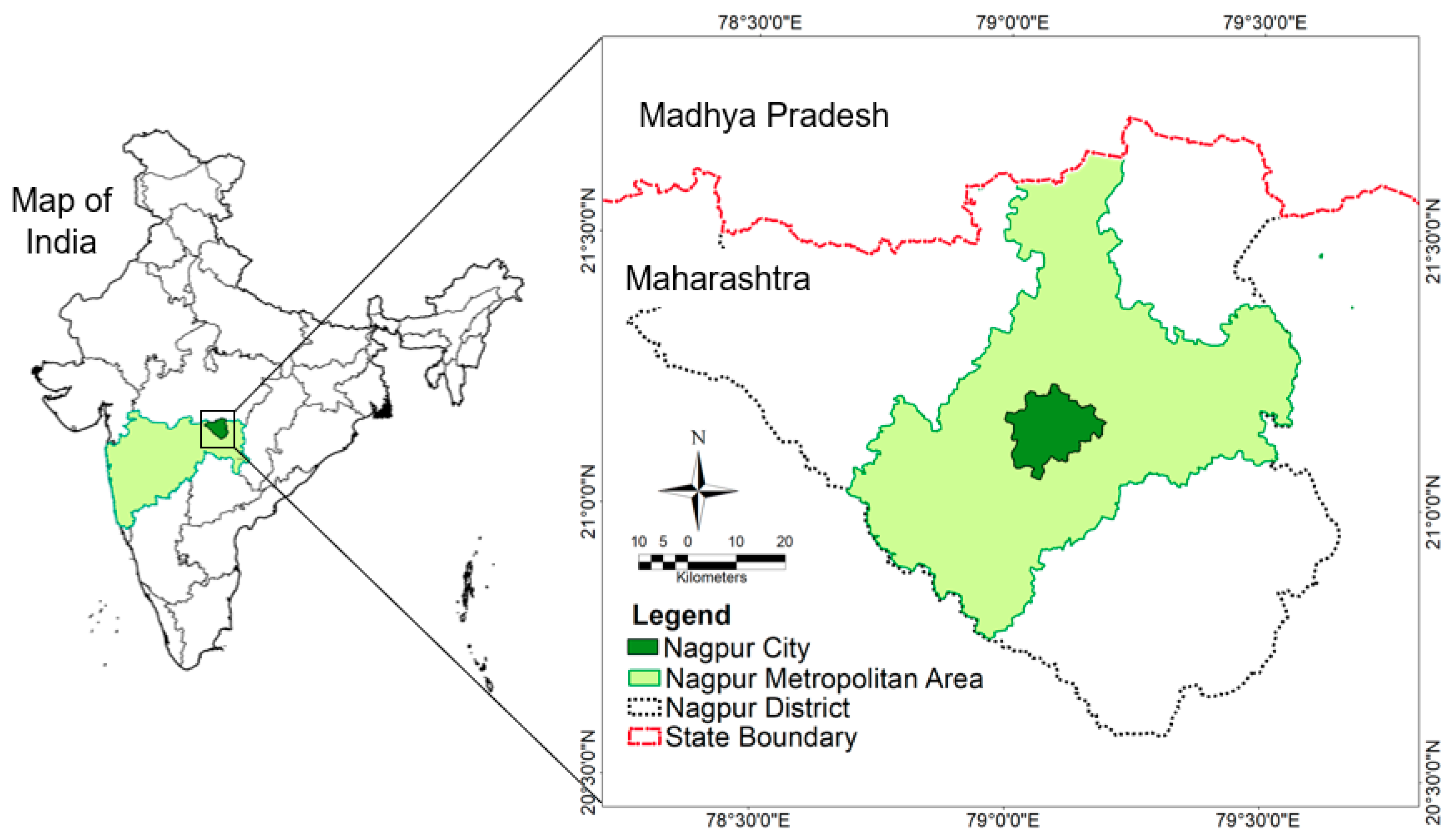
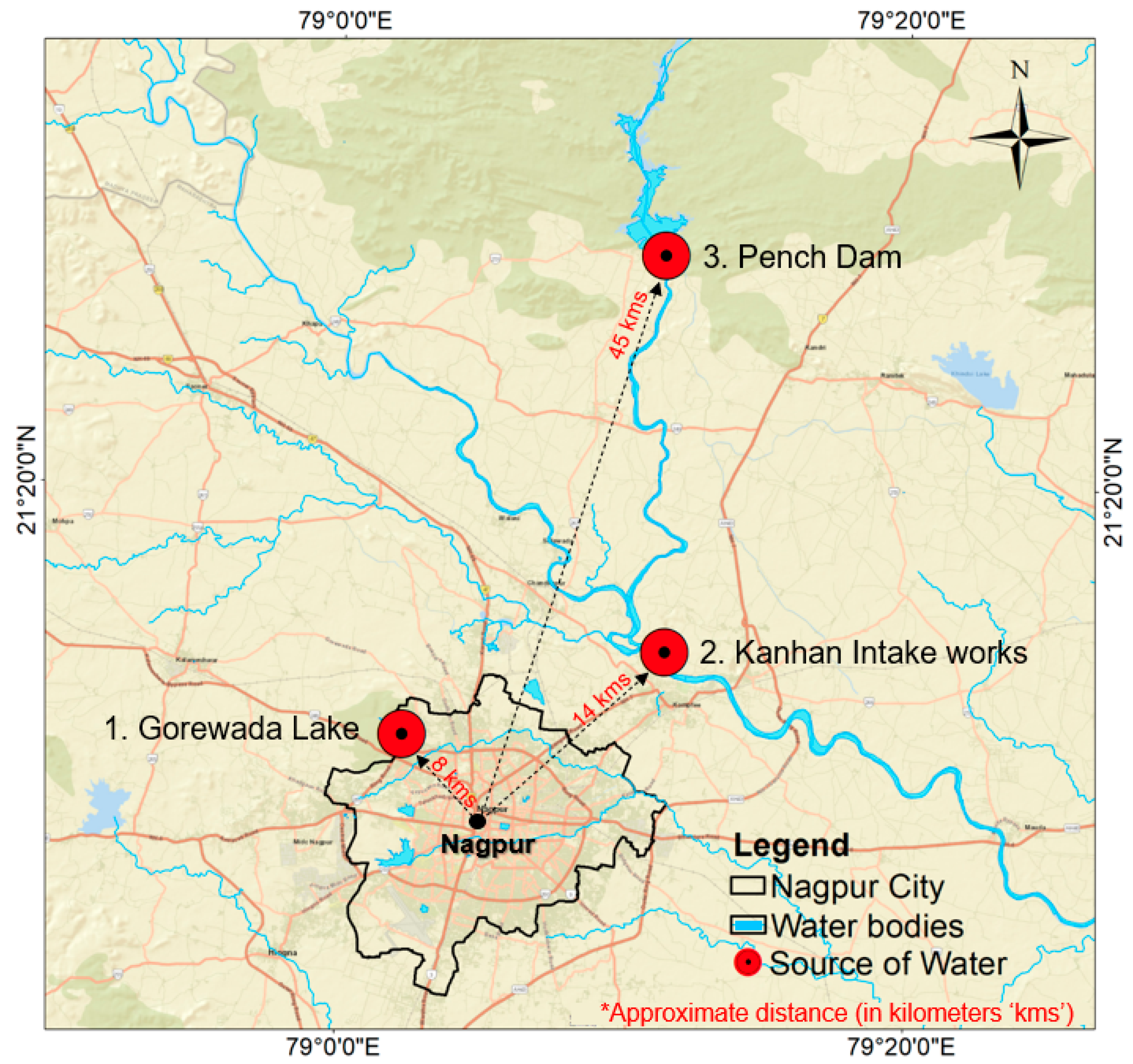
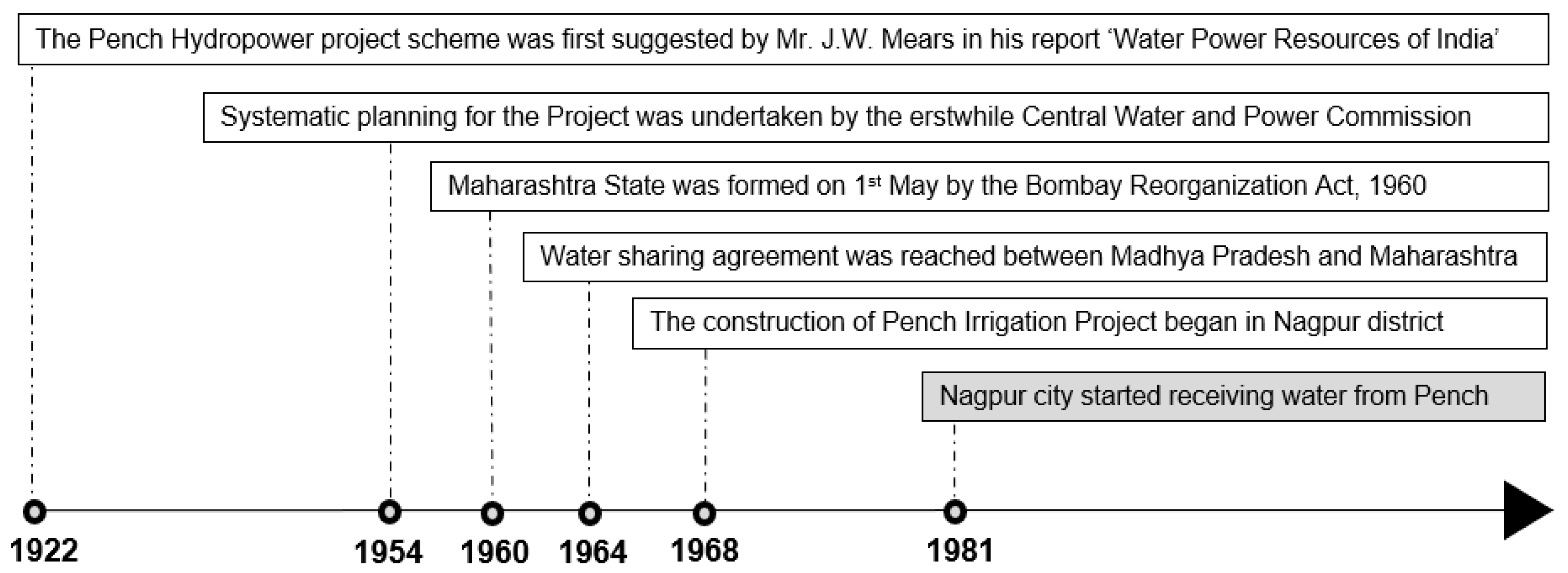
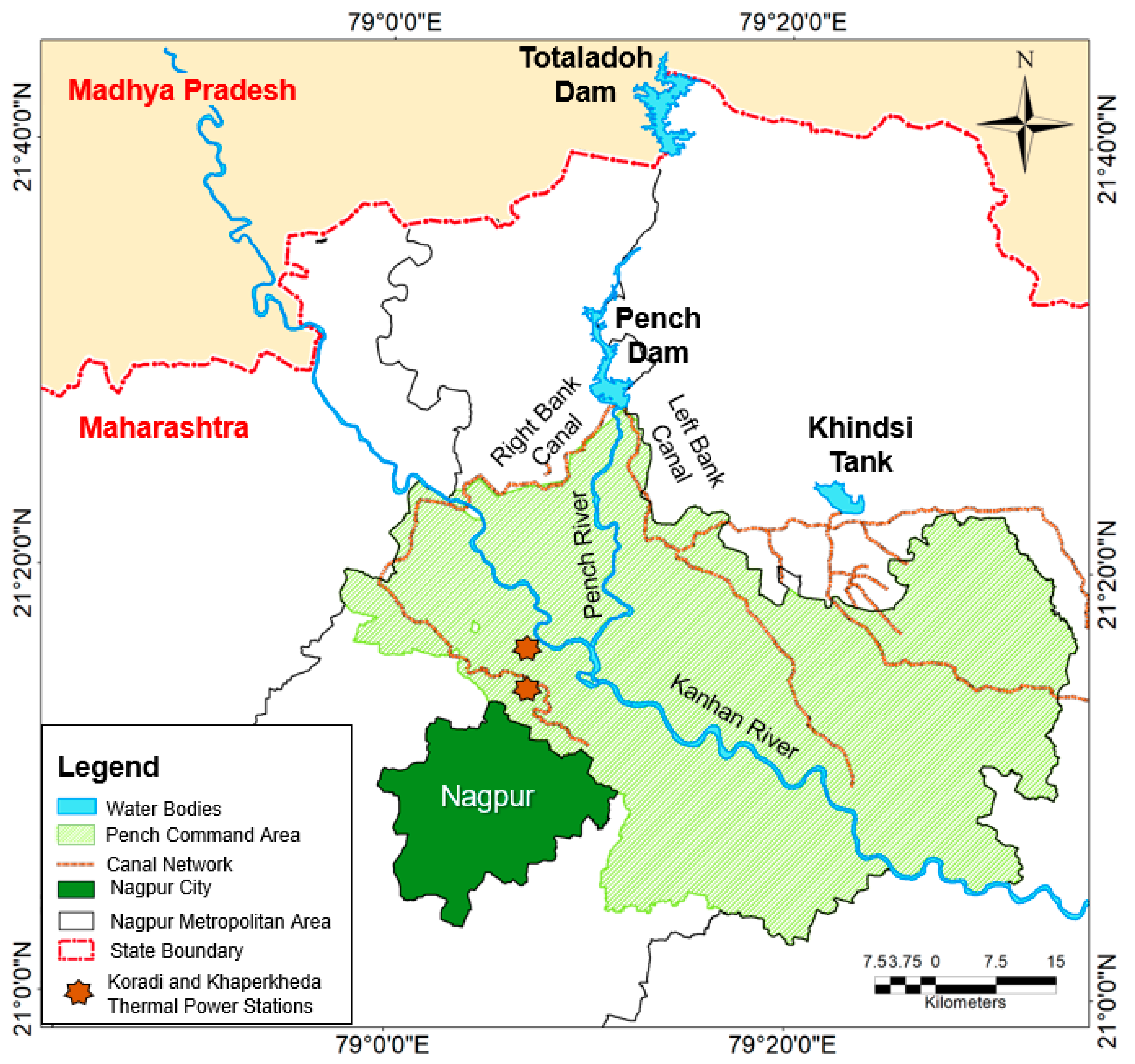
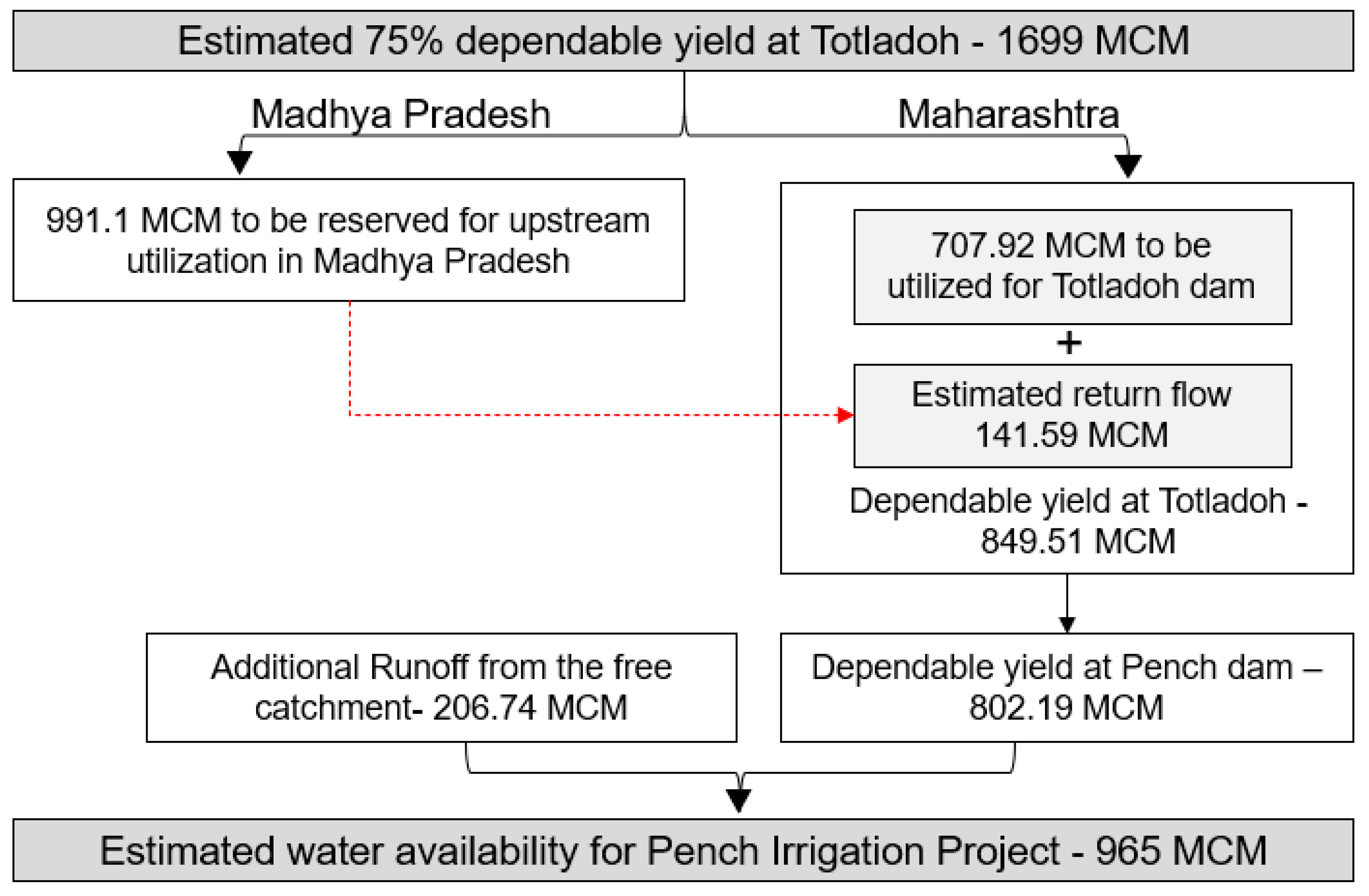
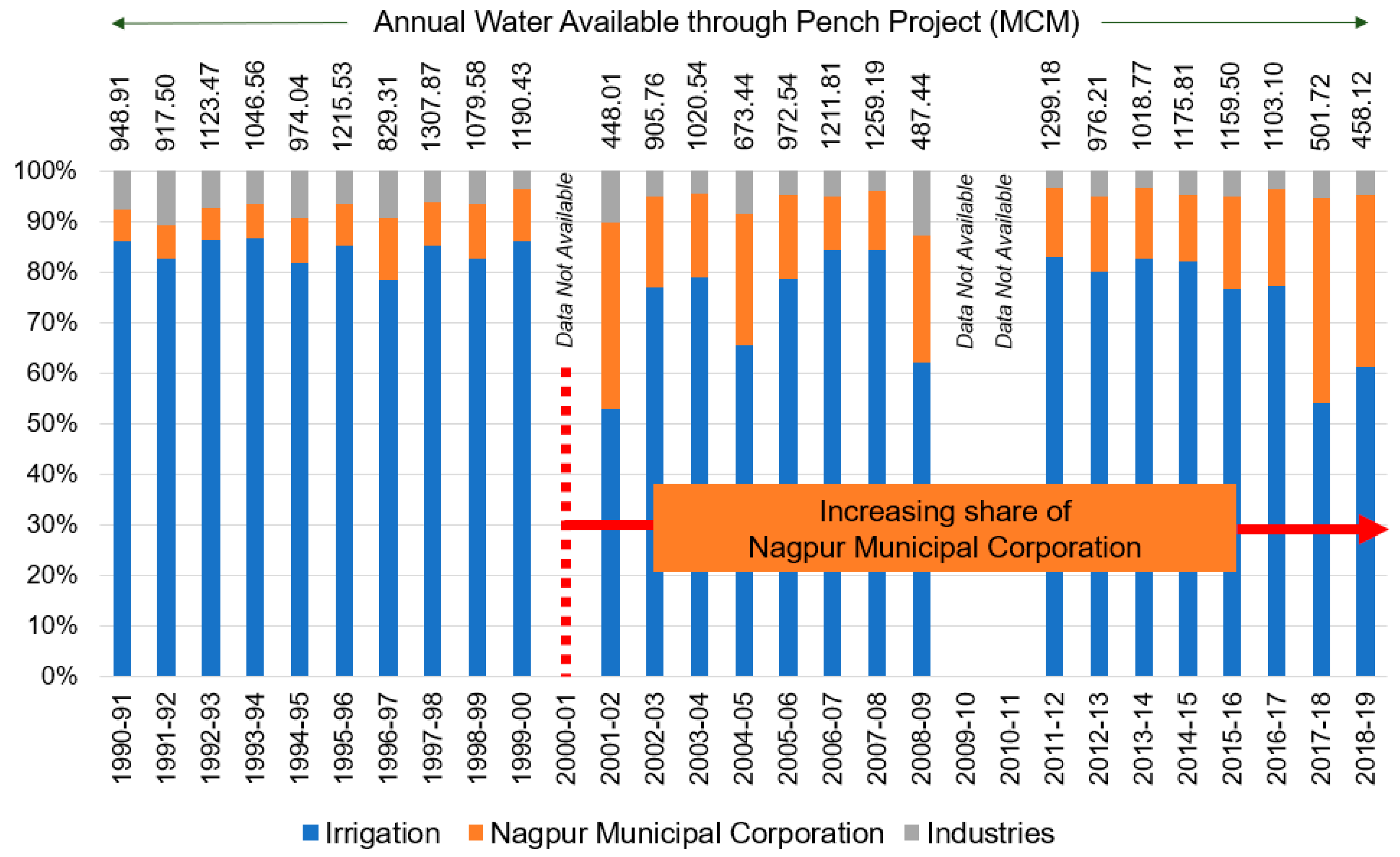
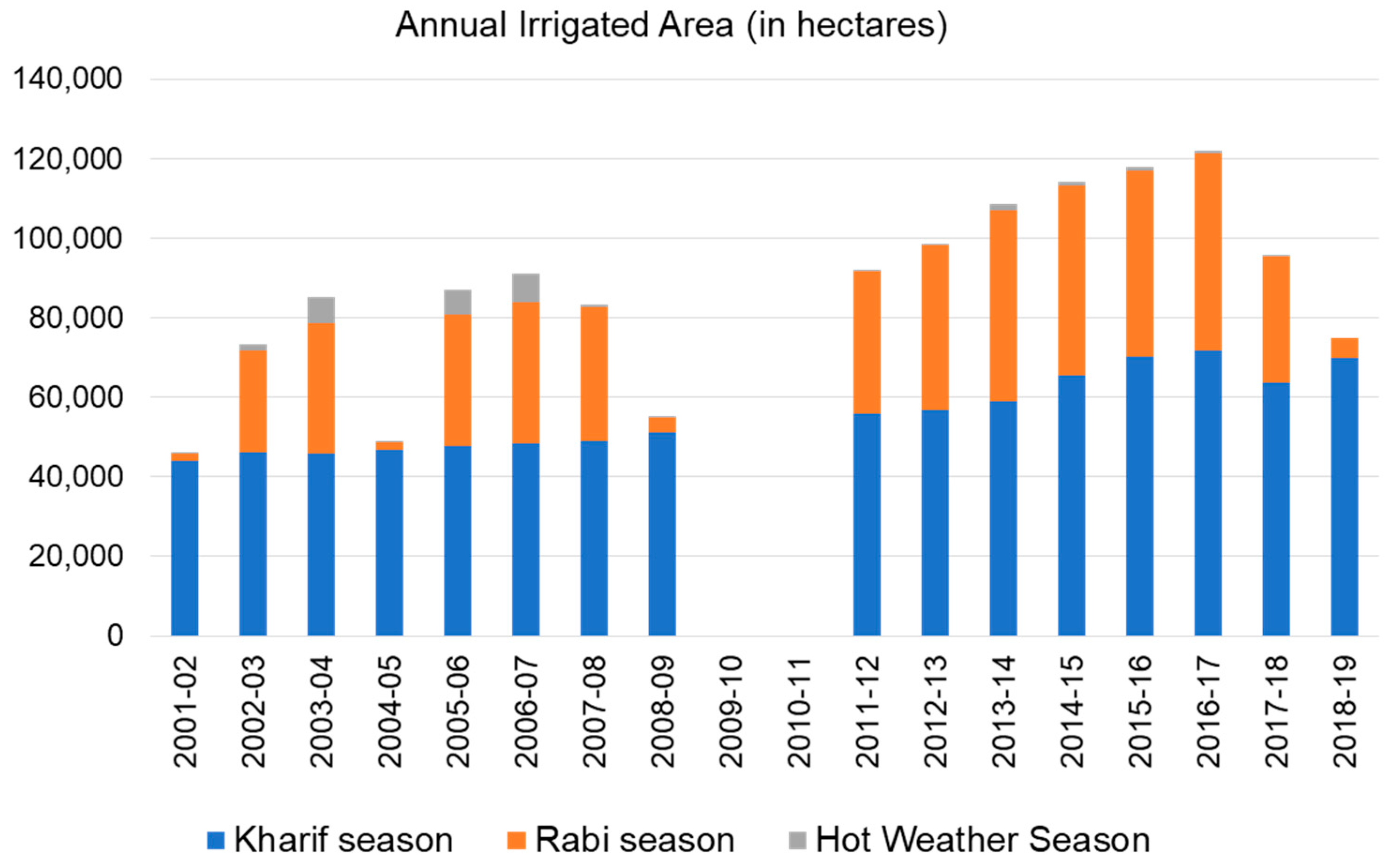
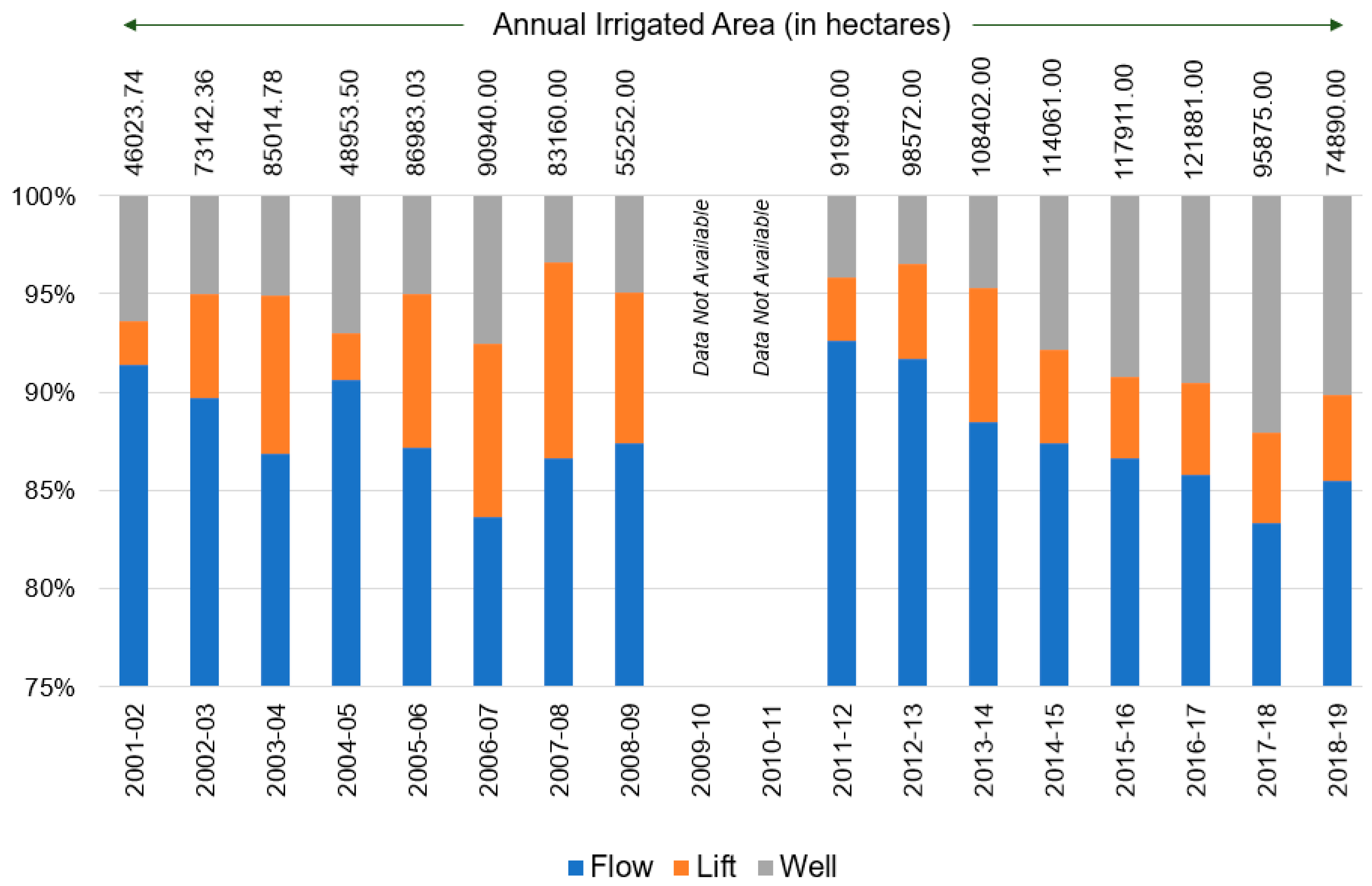
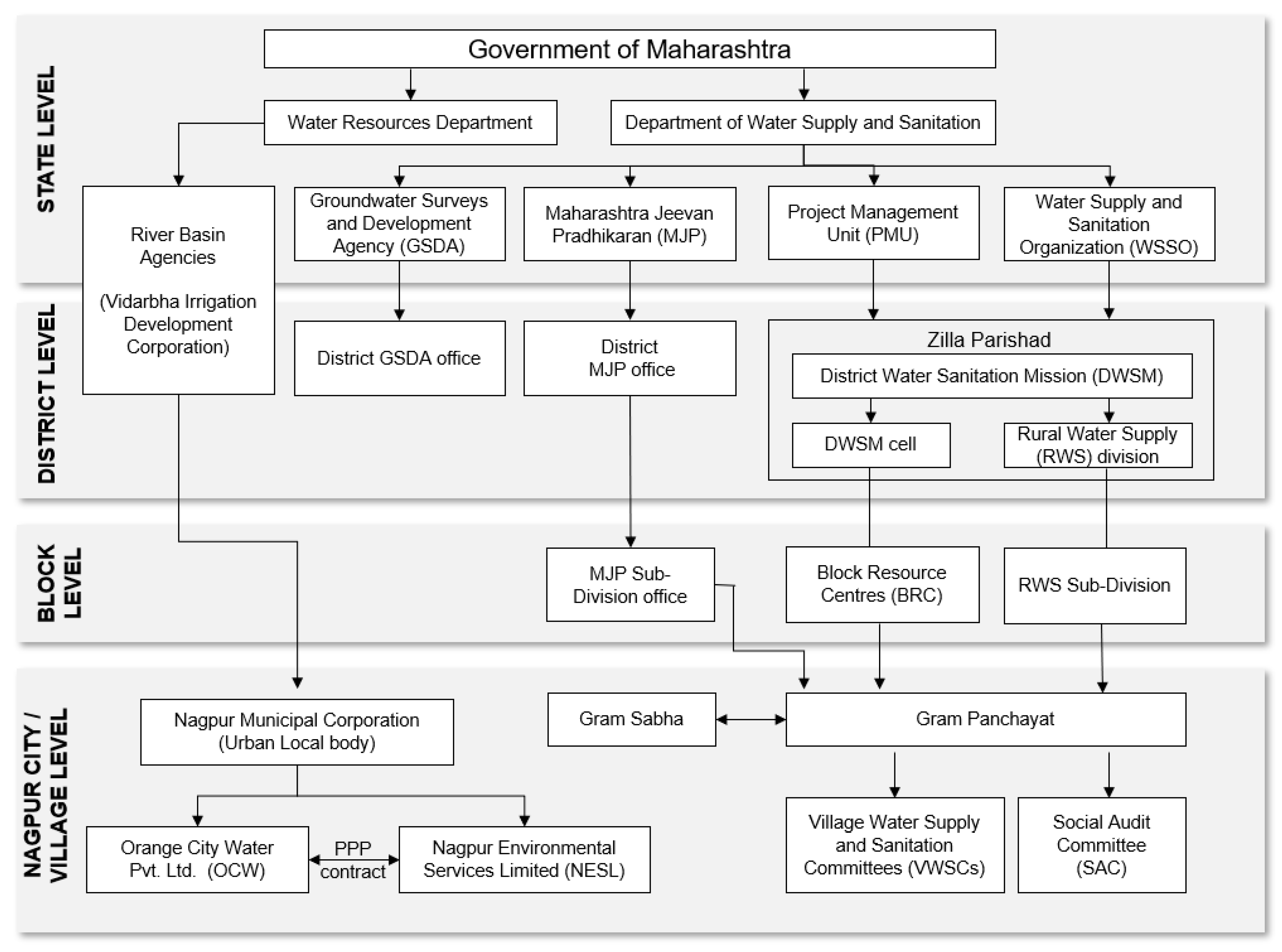
| Year | Population | Water Supply (in Million Liters Per Day) | LPCD Rate (Liters per Capita Per Day) | Surface-Water Sources |
|---|---|---|---|---|
| 1921 | 145,000 | 16.50 | 114 | Ambazari + Gorewada |
| 1941 | 302,000 | 45.00 | 149 | Ambazari + Gorewada + Kanhan |
| 1961 | 644,000 | 80.00 | 124 | Ambazari + Gorewada + Kanhan |
| 1981 | 1,217,000 | 125.00 | 103 | Gorewada + Kanhan |
| 2001 | 2,150,000 | 370.00 | 172 | Gorewada + Kanhan + Pench |
| 2004 | 2,350,000 | 470.00 | 200 | Gorewada + Kanhan + Pench |
| 2011 | 2,447,000 | 651.00 | 266 (including water losses) | Gorewada + Kanhan + Pench |
| S.No. | Description of Water User | Allocation |
|---|---|---|
| 1 | Irrigation | 689 |
| 2 | Nagpur Municipal Corporation | 112 |
| 3 | Koradi Thermal Power Station | 67 |
| 4 | Khaperkheda Thermal Power Station | 60 |
| 5 | Fisheries Department | 2 |
| 6 | Sunflag Industries, Bhandara | 2 |
| 7 | Evaporation losses | 33 |
| Total (in million cubic meters (MCM)) | 965 |
Publisher’s Note: MDPI stays neutral with regard to jurisdictional claims in published maps and institutional affiliations. |
© 2020 by the authors. Licensee MDPI, Basel, Switzerland. This article is an open access article distributed under the terms and conditions of the Creative Commons Attribution (CC BY) license (http://creativecommons.org/licenses/by/4.0/).
Share and Cite
Sukhwani, V.; Thapa, K.; Shaw, R.; Deshkar, S.; Mitra, B.K.; Yan, W. Addressing Urban–Rural Water Conflicts in Nagpur through Benefit Sharing. Water 2020, 12, 2979. https://doi.org/10.3390/w12112979
Sukhwani V, Thapa K, Shaw R, Deshkar S, Mitra BK, Yan W. Addressing Urban–Rural Water Conflicts in Nagpur through Benefit Sharing. Water. 2020; 12(11):2979. https://doi.org/10.3390/w12112979
Chicago/Turabian StyleSukhwani, Vibhas, Kamakshi Thapa, Rajib Shaw, Sameer Deshkar, Bijon Kumer Mitra, and Wanglin Yan. 2020. "Addressing Urban–Rural Water Conflicts in Nagpur through Benefit Sharing" Water 12, no. 11: 2979. https://doi.org/10.3390/w12112979
APA StyleSukhwani, V., Thapa, K., Shaw, R., Deshkar, S., Mitra, B. K., & Yan, W. (2020). Addressing Urban–Rural Water Conflicts in Nagpur through Benefit Sharing. Water, 12(11), 2979. https://doi.org/10.3390/w12112979







